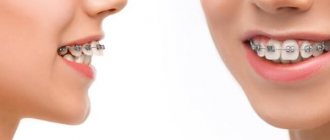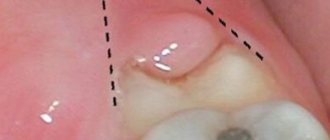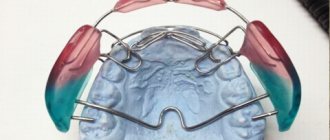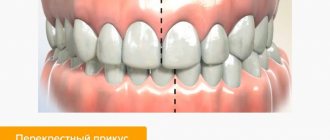9410
For any normal person, the news that he is about to undergo a surgical procedure does not evoke the most pleasant emotions. Many regard this almost as a death sentence.
The dental field is no exception. Any orthopedic procedure plunges the patient into unreasonable shock. In reality, not everything is dangerous, as the patient sometimes seems.
This article will answer questions about how justified surgical intervention is in orthodontic practice, whether there is an alternative, and what complications may arise after surgery.
Advantages
The main advantages of the operation as a method of correcting malocclusions:
- Improving the quality of life, confidence in one’s own attractiveness .
After this method of correction, the patient’s self-esteem increases, psychological complexes associated with personal failure and low self-esteem from a not very presentable appearance, in particular the oral cavity, are eliminated. - The time period of therapy is several times shorter than treatment with the same results, which involves partial amputation of organs.
- Formation of the correct lip position, restoration of the correct profile shape.
- With rare exceptions, this procedure involves complete preservation of healthy organs.
- Ease of maintaining the effectiveness of the treatment.
When surgically moving a jaw fragment to a given position, the organs do not try to repeat the trajectory of the jaw. On the contrary, they maintain their original position. In addition, the teeth are trying their best to come back. This effect is achieved only by wearing mouth guards for a long time. - Minimum retention period.
What is tooth enamel hypoplasia and what method can be used to eliminate the pathology?
Let's talk here about methods for correcting an open bite.
At this address https://orto-info.ru/sistemyi-vyiravnivaniya-zubov/breketyi/po-tipu-materiala/keramicheskie/clarity.html you will find a detailed description of the design of Clarity braces.
When orthognathic surgery is contraindicated
Surgeons will not undertake such an operation if the jaws have not yet formed - in adolescents and children. We also highlight such contraindications as:
- cardiovascular diseases;
- problems with blood clotting;
- the presence of precancerous and cancerous diseases;
- diseases of the endocrine or skeletal system;
- diabetes in some stages;
- disorders associated with mental state.
Specialists will most likely refuse those patients who think that this operation can improve their appearance, even without problems with their bite. With all the possibilities of orthognathic surgery to rejuvenate the patient and improve his appearance, it primarily solves serious problems with bite and should not be perceived as a beauty procedure.
Indications
The main indications for the operation are:
- pronounced jaw disproportions of an anatomical nature in combination with pathologies of the structure of the dentition;
- a significant violation of the relationship of the jaw fragments relative to each other, excessive development, or, on the contrary, physical underdevelopment of one of them, the inability to fully close the organs or lips (popularly this phenomenon is called the “bird face”). It is distinguished by a large lower jaw;
- a consequence of incorrectly performed surgical treatment of congenital facial abnormalities.
Do I need to prepare for orthognathic surgery?
The preparatory period can last more than one week. As mentioned above, orthognathic surgery is completely predictable. Therefore, at the first stage, the specialist decides what results should be after treatment:
✔
determines the necessary future parameters;
✔
finds the maximum possible number of closures between opposing teeth;
✔
monitors how the results of the operation will affect the patient’s appearance.
In most cases, when preparing for surgery, surgeons use special 3D modeling tools for the result. Thanks to the software, a template is obtained and the paths that will lead to the expected effect of orthognathic treatment are found.
Then orthodontic treatment with braces or aligners begins. This can take from several months to a year and a half. Once the dentition is aligned, orthognathic surgery can begin.
Orthognathic intervention takes 4-6 hours. Then the patient remains in the clinic for another 3-4 days under the supervision of the attending physician. Afterwards you can return home, and after 3 weeks you can go back to work.
Contraindications
The operation is not indicated for everyone. This method of treating bite pathologies should be abandoned in the following cases:
- age limit is less than 18 years;
- dentally unprepared organ fragments;
- general contraindications – dysfunction of the circulatory system, heart and vascular failure;
- diabetes;
- the presence of infections and inflammatory diseases of the oral cavity until their complete elimination;
- oncological diagnoses.
When is surgery needed for bite problems?
Specialists resort to surgical intervention when conventional orthodontic treatment methods have failed.
- Wearing permanent braces.
- Treatment with aligners.
- Installation of trainers (the method is suitable for children).
- Installation of veneers (used in mild cases of malocclusion).
- Laser bite correction.
Braces or removable aligners (teeth aligners) in most cases cope with the problem. However, with significant skeletal deformations, which are expressed in the disproportionate size of the jaws, their improper closure, and deformation of the chin, these methods are powerless.
Complex bite pathologies, for example significant closure defects, cannot be treated by wearing orthodontic structures for a long time. Orthodontists do not always take this fact into account. Meanwhile, focusing only on orthodontic treatment can have significant negative consequences for the patient: tooth dislocations or pathologies of the temporomandibular joint are quite possible in this case. And they bring with them completely different problems: pain in the head and back, disorders of the gastrointestinal tract and other diseases that at first glance are difficult to associate with malocclusion pathologies.
Varieties
Orthognathic surgery itself is aimed at solving a specific problem, and there are several treatment options.
Which one will be a priority is decided by the doctor based on the clinical picture of the disease.
Maxillary osteotomy
During the manipulation, the surgeon makes incisions in the bony intraoral tissues located in the area of the eye sockets and the upper part of the dentition.
This step allows the doctor to freely move the upper jaw with tooth fragments and the palatal area. The jaw is set in a given position and secured using a special mouthguard.
Mandibular osteotomy
A significant difference from the procedure described above is that the doctor makes an incision in the bone tissue in a place located behind the root organs. Thus, its integral movement becomes possible.
The fragment is given the desired position, secured with durable titanium alloy plates and left in this state until new hard tissue grows.
Signs of mesial occlusion and treatment offered by modern clinics.
In this publication we will discuss the principle of operation of the Derichsweiler apparatus.
Follow the link https://orto-info.ru/sistemyi-vyiravnivaniya-zubov/breketyi/po-raspolozheniyu/lingvalnyie/inkognito.html if you are interested in the design of Incognito lingual braces.
Genioplasty
It is considered a cosmetic procedure that corrects plastic surgery. Its task is to qualitatively reduce or increase the size of the chin, as well as slightly correct its shape.
The duration of the procedure is determined by the degree of development of the anomaly. When changing an organ, the surgeon uses special prosthetic structures, which he inserts into an internal hole prepared in advance.
To prevent a scar from appearing after this, manual distribution of soft subcutaneous tissue fragments is carried out.
Orthognathic surgery: what is it?
This is a surgical correction of the bite. During the operation, not only the bite is corrected, but also externally noticeable facial asymmetry: the surgeon shortens or lengthens the jaw, corrects its location, and changes the size of the chin. At the same time, along with the bone structure, soft tissues are also transformed. Therefore, a person’s appearance changes for the better.
Preparation
Before surgical intervention, a set of general preparatory measures is indicated:
- Bringing the oral cavity back to normal – eliminating plaque and calculus, eliminating caries manifestations. Amputation of the root part of organs and removal of decayed teeth.
- Leveling manipulations are a long period and involve the use of braces. After the course of treatment, the specialist, based on the results obtained, plans to correct the bite through surgery.
- Computer preparation - using modern programs, they plan a treatment regimen aimed at correcting the defect and calculate the expected result.
This is possible using 3D technologies that project a panoramic image. Based on the results of such forecasting, a template layout of the future face is drawn up.
Before the procedure itself, you must adhere to certain requirements:
- 7-8 hours before the expected start of the manipulation, do not eat or drink water;
- give up alcohol and smoking one day before;
- If you have any viral or inflammatory diseases or general malaise, immediately inform your doctor and reschedule the procedure.
How are orthognathic surgeries performed?
Any modern orthonic procedure is performed using internal access to the oral cavity. This means that there will be no external cuts, wounds, or scar tissue. The type of anesthesia is also selected in each specific case - it all depends on the type of operation. The average duration of the procedure is from 30 minutes to 5 hours, respectively.
Benefits of jaw surgery:
- “Turnkey” harmonization – the operation allows you to eliminate both functional and aesthetic problems;
- Monitoring the condition after surgery - the doctor monitors the recovery process until the patient is completely satisfied with the result;
- Modern surgical intervention is as gentle as possible, on an outpatient basis, without the need for a long break from work.
What to take with you to the hospital
The clinic will definitely need:
- passport, referral for surgery and outpatient card;
- personal clothing and footwear;
- Personal hygiene products, optional, towel and bed linen;
- a special sippy cup with a spout, since during the rehabilitation period, especially in the first days, the process of drinking in traditional ways will cause physical difficulties and pain.
You will learn what orthognathic surgery means from the video.
Postoperative care
You can brush your teeth as usual after surgery, avoiding the incision area. You should rinse your mouth with an antiseptic solution such as Chlorhexidine three times a day. In this case, there is no need to strain the chewing muscles - you can only shake your head, since too intense movements can cause the seams to separate. As far as diet is concerned, it is necessary to eat soft foods. Avoid food and drinks that are too hot. During the postoperative period, you should not drink alcoholic beverages, smoke, take hot baths, or visit the bathhouse or sauna. Intense sports and heavy lifting should also be postponed for a while.
Possible complications
If the operation is performed correctly, complications are the exception rather than the rule. But, nevertheless, they sometimes happen. The most common:
- Rupture of the nerve of the lower jaw - occurs during osteotomy. Since the nerve is completely exposed during the operation, there is a risk of damage or complete rupture. Externally, the defect does not appear in any way.
- Damage to the infraorbital nerve affects the inhibition reflexes of nerve impulses. It provokes expansion of the infraorbital canal, which is normally somewhat narrowed. It goes away gradually and spontaneously.
- Damage to the facial nerve is fraught with fragmented numbness of the labial region. Doesn't affect facial expressions.
- Blood loss during manipulation depends on the individual characteristics of the body, and the quality of functioning of the circulatory system, in particular, blood clotting. The complication does not pose a serious threat to the patient’s health.
- Scar formation depends on the sensitivity and structural content of the skin. It can be eliminated with special creams with a wound-healing effect. Not dangerous.
- Damage to teeth occurs due to poor quality of manipulation and lack of professionalism of the doctor. The only solution in this situation is artificial restoration of organs.
- Unexpected bone osteotomy - another operation will most likely be required to eliminate the pathology. The complication arises due to the anatomical features of the patient’s jaw structure and the mobility of bone tissue.
- Deformation and asymmetry are a temporary phenomenon; as the source of inflammation heals, it goes away spontaneously; in severe cases, it is corrected surgically.
- Inflammation - occurs when the oral cavity becomes unintentionally infected.
- A jaw fracture is the result of extreme unprofessionalism of the surgeon. Requires urgent surgical correction.
How much does orthognathic surgery cost?
Prices depend on the diagnosis and type of surgery. On average, the approximate cost is:
- the most expensive operation is moving the lower or upper jaw. Costs from 300 thousand rubles;
- the price of expanding the upper jaw costs about 100 thousand rubles;
- The estimated cost of marginal resection of the lower jaw is from 115 thousand rubles.
It is important that after the operation the patient will not only be able to smile and talk freely, but will also enjoy harmonious facial proportions. Also, many patients get rid of snoring, shortness of breath and other problems that affect their quality of life.
Stage III - final orthodontic correction
Goals of the stage: creation of correct interdental contacts, finalization and stabilization of the bite.
Photo after surgery to correct the bite:
The patient is prescribed to wear orthoelastics. The orthodontist gave the patient a plan for wearing orthoelastics. They need to be changed every day, fastening each time according to the established pattern. You need to wear orthoelastics constantly, as prescribed by your doctor, this affects the results of treatment.
What is the cost of orthognathic surgery?
An accurate calculation of the cost of surgical intervention can only be done individually after consultation with an orthodontist and a surgeon in the clinic of your choice. Plus, you will always additionally need to take a panoramic image or computed tomography of the maxillofacial region, condylography. In addition, correcting the bite may require the participation of related specialists.
When searching for a suitable dentist, pay attention to the clinic’s special offers: in some cases, you may be offered to pay for services in installments or in parts.










